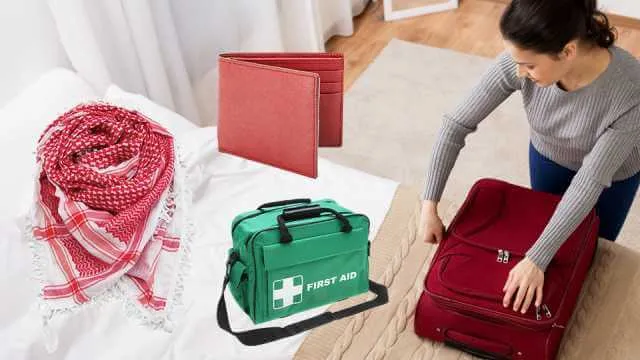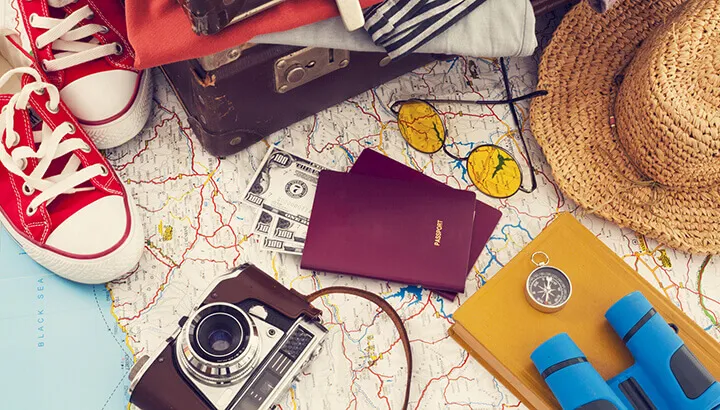
- Share on Facebook1
- Share on Pinterest
- Share on Twitter
Every traveler knows to bring a camera and photocopies of important documents, but what about a fake wallet or endless supply of padlocks? For this list, we’re looking at some of the less obvious, yet surprisingly important items you might want to throw in your backpack before heading on your next trip. I never leave home without each of these items, and you shouldn’t either.
1. Fake wallet or fake passport
If you travel long enough, it’s only a matter of time before someone tries to mug you. Most people recommend that during a mugging, you should promptly hand over your wallet, no questions asked. I agree, which is why I always keep a fake wallet on hand. My fake wallet is packed with expired bank cards, a decade-old ID card and a stack of the most worthless currencies in the world.
Just because I like to pay attention to details, I also like to throw a few American dollars in to serve as bookends for the less valuable currencies, such as the pile of worthless Bolivian bolivianos and Algerian dinars. To complement my fake wallet, I also keep an old, expired passport inside a shiny new plastic passport jacket. It’s not perfect, but more than enough to momentarily fool a would-be mugger late at night.
2. Money, money, money

Speaking of valuables, it’s always worth having a few different ways to access your travel funds. Along with the obvious debit card, a prepaid travel card can also be useful. These cards work just like credit cards, except the only money on them is whatever you decided to upload before leaving home. Most major banks offer some kind of travel card, and they’re great — especially during express kidnappings.
Along with cards, I’d also suggest bringing a stash of US dollars. In some parts of Africa, you may want to consider mixing these with some euros, though generally dollars are the easiest currency to exchange the world over. Either way, carrying hard cash can be risky, but sometimes the risk of not being able to find a functional ATM is higher.
3. Padlocks
Bring more padlocks than you need, and use them for everything. If you need to leave your bag in a coatroom at a museum, a discrete padlock can offer a little peace of mind. When you sleep in dorm, you can padlock your bag to yourself. On the subway, a few padlocks can mean one less potential weak point for pickpockets to exploit. In general, padlocks are the silent workhorses of the diligent traveler.
4. Notepad and three pens
A notepad is the single most important thing you can carry. Keep it close at hand, and jot down everything. Take notes on your surroundings so you don’t get lost, whip it out when you need to take down contact details and use it while haggling over prices. Keep at least three pens at all times; this is because one will inevitably break almost immediately, leaving you with one other pen to use and a third as a backup.
5. Coordinated clothing
One of the biggest mistakes travelers make is to pack a mound of their favorite clothes, with no sense of how they all fit together. Whether you’re a fashionista or unwashed hippie, you’re going to want to maximize the utility of your backpack wardrobe. The easiest way to do this is to ensure you feel comfortable wearing any and every article of clothing with any other in your backpack. This means sticking to a single style and maintaining a uniform palette. Ideally, any random mix of clothes you fish out of your bag should form a perfectly acceptable outfit.
6. MSR Whisperlite Universal
This is probably the most optional item on this list, especially for anyone who doesn’t plan to spend much time in the great outdoors. However, for any travelers who plan on doing any camping, a reliable stove is essential. No stove is more reliable or essential than the MSR Whisperlite Universal. Often called the AK-47 of camping stoves, the Whisperlite is compact, lightweight and versatile. You can drag it through the mud and it’ll still work. It’ll burn like a dream on frozen tundra, in pouring rain or the humidity of the Amazon. It can run on anything from white gas to unleaded gasoline, threaded butane to kerosene. Nothing can stop the Whisperlite. Plus, it’s easy to clean and maintain on the road.
7. A Kindle or e-reader
Whether you’re huddled around the campfire deep in the Himalayas, or looking for a way to kill a lazy afternoon on a beach in the Bahamas, you can always do with a good book. A Kindle or e-reader cuts down weight, allowing you to carry a library in your backpack. Never leave home without one.
8. Keffiyeh

The classic lightweight desert scarf is popular among everyone from well-heeled hipsters to grizzled guerrillas — and with good reason. This simple accessory has an endless list of uses, and you’ll be surprised just how helpful a simple square of calico can be. Along with warding off the chill, I’ve used my keffiyeh as a towel, a Kindle protector, a balaclava, an improvised sack, a sarong, a beach towel, a stove cleaner, a pillow and more. They also look great with any outfit, in any climate.
9. A first aid kit
This should seem obvious, but many novice travelers forget to bring a well-stocked medkit. At the very least, your kit should include painkillers, anti-diarrhea pills, iodine tablets, antiseptic, a bandage, gauze pads, blister treatment, hand sanitizer, bug repellent, scissors, tape, gloves, lip balm and an endless supply of band aids.
It’s also good to have some antibiotics on hand. Cipro is a good choice for general bacterial infections, while Erythromycin is good for respiratory infections and Metronidazole is a godsend for handling anaerobics. For women, Diflucan or Terazol are good to have if you’re going to spend a lot of time on long road trips in hot climates, or are otherwise prone to yeast infections. For more ideas, take a look at the Red Cross recommendations.
— Ryan Mallett-Outtrim
- Share on Facebook1
- Share on Pinterest
- Share on Twitter

